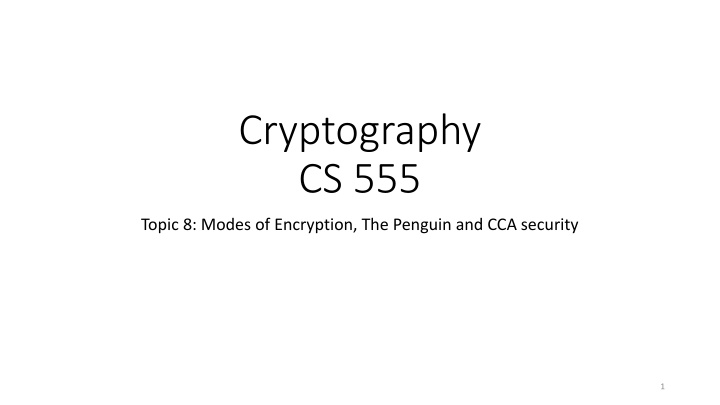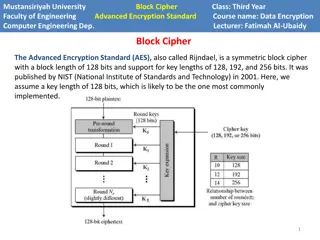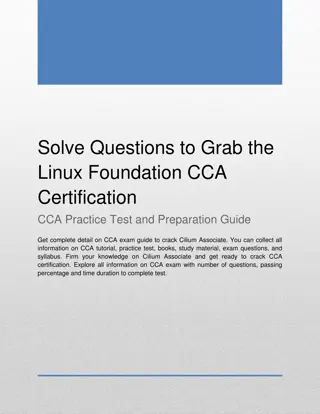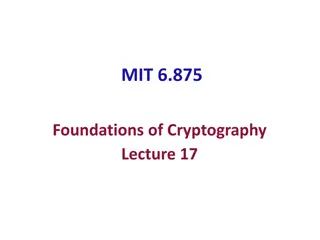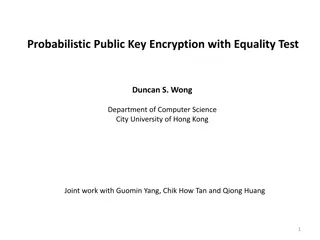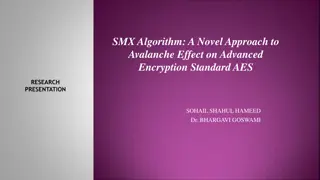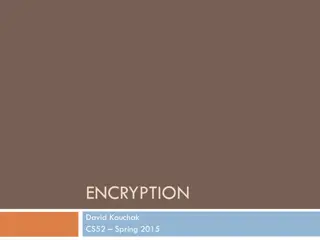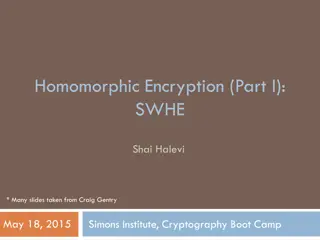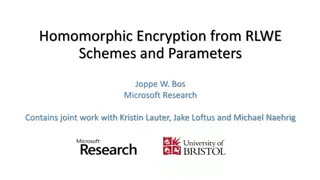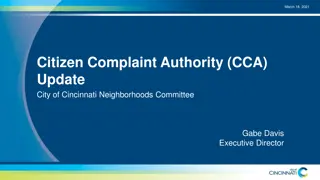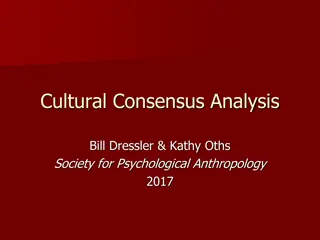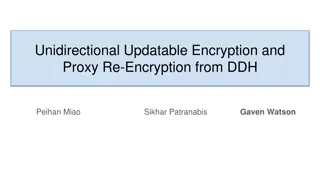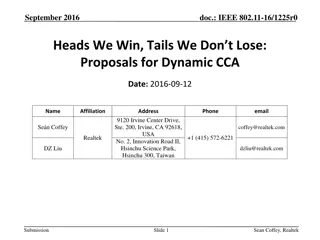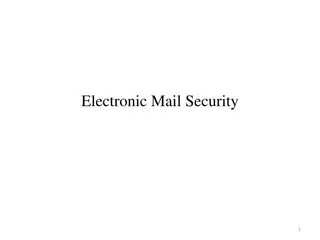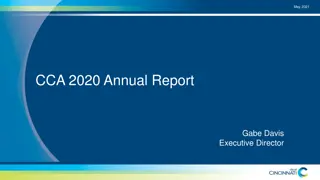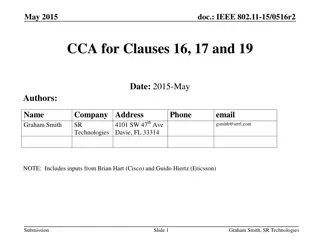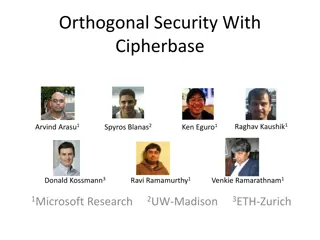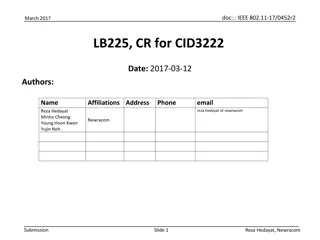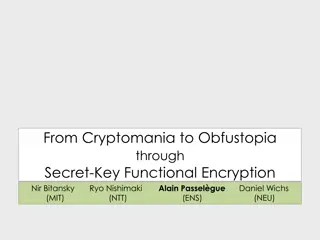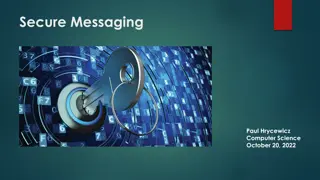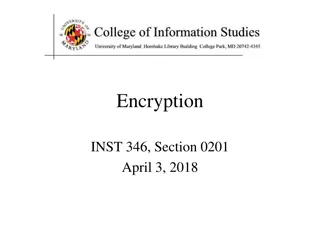Modes of Encryption and CCA Security Overview
An overview of various modes of encryption, including stream ciphers and block ciphers, along with a discussion on Chosen Ciphertext Attacks and CCA Security. The content covers the goals of the day, examples of attacks, and definitions related to CCA-Security. It explains how CPA-Security differs from CCA, and provides insights into the encryption schemes and adversary behaviors in the context of security protocols.
Download Presentation

Please find below an Image/Link to download the presentation.
The content on the website is provided AS IS for your information and personal use only. It may not be sold, licensed, or shared on other websites without obtaining consent from the author.If you encounter any issues during the download, it is possible that the publisher has removed the file from their server.
You are allowed to download the files provided on this website for personal or commercial use, subject to the condition that they are used lawfully. All files are the property of their respective owners.
The content on the website is provided AS IS for your information and personal use only. It may not be sold, licensed, or shared on other websites without obtaining consent from the author.
E N D
Presentation Transcript
Cryptography CS 555 Topic 8: Modes of Encryption, The Penguin and CCA security 1
Reminder: Homework 1 Due on Friday at the beginning of class Please typeset your solutions 2
Recap Pseudorandom Functions CPA-Security Today s Goals: Evaluate several modes of operation for stream-ciphers + block- ciphers IntroduceChosen Ciphertext Attacks/CCA-Security Construct encryption scheme with CCA-Security 3
Chosen Ciphertext Attacks Sometimes an attacker has ability to obtain (partial) decryptions of ciphertexts of its choice. CPA-Security does not model this ability. Examples: An attacker may learn that a ciphertext corresponds to an ill-formed plaintext based on the reaction (e.g., server replies with invalid message ). Monitor enemy behavior after receiving and encrypted message. Authentication Protocol: Send Enck(r) to recipient who authenticates by responding with r. 4
We could set m0 = m-1 or m1 = m-2 CCA-Security (Ind-CCA2) m-1 c-1 = EncK(m-1) c-2 m-2 = DecK(c-2) m0,m1 However, we could still flip 1 bit of c and ask challenger to decrypt c = EncK(mb) m3 c2 = EncK(m2) Random bit b K = Gen(.) c3 m3 = DecK(m3) c4 =c No Way! b 5
???? CCA-Security ??????, 1. 2. 3. 4. 5. Challenger generates a secret key k and a bit b Adversary (A) is given oracle access to Enck and Deck Adversary outputs m0,m1 Challenger sends the adversary c=Enck(mb). Adversary maintains oracle access to Enck and Deck ,however the adversary is not allowed to query Deck(c). Eventually, Adversary outputs b . ??????, 6. ???? = 1 if b = b ;otherwise 0. CCA-Security: For all PPT A exists a negligible function negl(n) s.t. ???? = 1 1 Pr ??????, 2+ ????(?) 6
CCA-Security Definition 3.33: An encryption scheme is CCA-secure if for all PPT A there is a negligible function negl(n) such that ???? = 1 1 Pr ??????, 2+ ????(?) 7
CPA-Security doesnt imply CCA-Security Enck(m) = ?,??? ? Attacker: Selects m0 = 0n and m1 = 1n Attacker Receives: c = ?,?where ? = ??? ?? Attacker Queries: Deck(c ) for c = ?,s 10? 1 Attacker Receives: 10? 1(if b=0) or 01? 1 (if b=1) Example Shows: CCA-Security doesn t imply CCA1 Security (Why?) 8
Attacks in the Wild Padding Oracle Attack Length of plaintext message must be multiple of block length Popular fix PKCS #5 padding 4 bytes of padding (0x04040404) 3 bytes of padding (0x030303) Bad Padding Error Adversary submits ciphertext(s) and waits to if this error is produced Attacker can repeatedly modify ciphertext to reveal original plaintext piece by piece! 9
Example M= hello please keep this message secret +0x030303 C = ?,? = ??? ? C = ?,??? ? 0x0000 .30000 Ask to decrypt C If we added < 3 bits of padding C can be decrypted. Otherwise, we will get a decryption error. Once we know we have three bits of padding we can set C = ?,? = ??? 0x0000 .30303 0x0 ??040404 If C decrypts then we can infer the last byte t from ?? 0x04. 10
CCA-Security Gold Standard: CCA-Security is strictly stronger than CPA-Security If a scheme has indistinguishable encryptions under one chosen- ciphertext attack then it has indistinguishable multiple encryptions under chosen-ciphertext attacks. None of the encryption schemes we have considered so far are CCA- Secure CCA-Security implies non-malleability (message integrity) An attacker who modifies a ciphertext c produces c which is either Invalid, or Decryptions to unrelated message 11
Back to CPA-Security We will build a CCA-Secure Encryption scheme later in the course We will need to introduce additional tools (Message Authentication Codes) Remaining Lecture: Modes of Operation for Stream-Ciphers and Block-Ciphers 12
CPA-Secure Encryption Enck(m) = ?,??? ? Deck( ?,? ) = ??? ? Drawbacks: Encryption is for fixed length messages only Length of ciphertext is twice as long as message Attacker can still tamper with ciphertexts to flip bits of plaintext Stream Ciphers/Block Ciphers CCA Security 13
Stream Ciphers Modes What if we don t know the length of the message to be encrypted a priori? Stream Cipher: ? ?,1? outputs n pseudorandom bits as follows Initial State: st0 = Initialize(s) Repeat (yi,sti)=GetBits(sti-1) Output yi Synchronized Mode Message sequence: m1,m2, Ciphertext sequence: ci = mi yi (same length as ciphertext!) CPA-like security follows from cipher security (must stop after n-bits) Deterministic encryption, what gives??? Requires both parties to maintain state (not good for sporadic communication) 14
Stream Ciphers Modes What if we don t want to keep state? Unsynchronized Mode Message sequence: m1,m2, Ciphertext sequence: ci= IV, ?? ? ?,??,1?? CPA-Secure if Fk(IV) = ? ?,??,1? is a (weak) PRF. No shared state, but longer ciphertexts . 15
Pseudorandom Permutation A keyed function F: 0,1? 0,1? 0,1?, which is invertible and looks random without the secret key k. Similar to a PRF, but Computing Fk(x) and ?? 1? is efficient (polynomial-time) Definition 3.28: A keyed function F: 0,1? 0,1? 0,1? is a strong pseudorandom permutation if for all PPT distinguishers D there is a negligible function ? s.t. ?? ???. ,?? ?? ?? . ,? 1.1? 1.1? ? ? 17
Pseudorandom Permutation Definition 3.28: A keyed function F: 0,1? 0,1? 0,1? is a strong pseudorandom permutation if for all PPT distinguishers D there is a negligible function ? s.t. ?? ???. ,?? ?? ?? . ,? 1.1? 1.1? ? ? Notes: the first probability is taken over the uniform choice of ? 0,1? as well as the randomness of D. the second probability is taken over uniform choice of f Permnas well as the randomness of D. D is never given the secret k However, D is given oracle access to keyed permutation and inverse 18
Electronic Code Book (ECB) Mode 1? Uses strong PRP Fk(x) and ?? Enck Input: m1, ,m Output: Fk(m1), ,Fk(m ) How to decrypt? Is this secure? Hint: Encryption is deterministic. Implication: Not CPA-Secure But, it gets even worse 19
The Penguin Principle If you can still see the penguin after encrypting the image something is very very wrong with the encryption scheme. 21
Cipher Block Chaining CBC-Mode (below) is CPA-secure if Ek is a PRP Reduces bandwidth! IV Message: 3n bits Ciphertext: 4n bits IV 22
Chained CBC-Mode m4 m6 m5 IV c3 c4 c6 IV c5 First glance: seems similar to CBC-Mode and reduces bandwidth Vulnerable to CPA-Attack! (Set m4= IV ?3 ?1 Moral: Be careful when tweaking encryption scheme! and c4=c1 iff m1=m1 ) 23
Counter Mode Input: m1, ,mn Output: c = (ctr, c1,c2, ,cn) where ctr is chosen uniformly at random Theorem: If Ek is PRF then counter mode is CPA-Secure Advantages: Parallelizable encryption/decryption 24
Next Class Read Katz and Lindell 4.1-4.2 Message Authentication Codes (MACs) Part 1 25
